Table of Contents
-
I Overview of Pomegranate
- 1 Introduction
- 2 Pomegranate in one paragraph
-
3 Explanation of each term
- 3.1 …work management…
- 3.2 …knowledge management…
- 3.3 …open source…
- 3.4 …system…
- 3.5 …cross-platform…
- 3.6 …comprehensive…
- 3.7 …integrated…
- 3.8 One vs many tools
- 3.9 … web application
- 3.10 …written in Grails …
- 3.11 Global context of Pomegranate
- 3.12 Other options
- 3.13 Using an existing established application
- 3.14 Using an online application
- 3.15 Target users
- 3.16 Origin of name Pomegranate?
- 4 Book scope
- 5 Acknowledgements
- 6 History
- 7 Goals of Pomegranate
- 8 Structure of the Records
- II Features of Pomegranate
- III PKM In Action
I Overview of Pomegranate
1 Introduction
Much has been written about knowledge management in the context of organizations and innovative industries, but little is written in the context of the individual person, who can be a writer, researcher, blogger, or life-long learner. Pomegranate PKM is an open source system that aims to help such individuals in managing their work, from goal to publication.
This book outlines the motivations, design principles and the features of Pomegranate PKM, a powerful new open source system to manage work and knowledge in an integrated manner.
2 Pomegranate in one paragraph
Pomegranate PKM is a new open source web-based cross-platform work and knowledge management system for productive and prolific people. PKM features text-based commands for adding, updating and searching records, thus providing powerful tools to manage information. It also allows the user to build up the navigation menu using saved searches.

Overview
3 Explanation of each term
3.1 …work management…
3.2 …knowledge management…
Management vs organization
Definition of personal knowledge management
3.3 …open source…
3.4 …system…
Pomegranate is not just
The terms application and system are used interchangebly in this book. The term application is more suitable when the technical aspects of Pomegranate are mentioned. While the term system is more suitable when the motivation and design principles are mentioned.
3.5 …cross-platform…
3.6 …comprehensive…
Pomegranate PKM manages:
- Goals, tasks, and plans
- Journal and indicators
- Writings and notes
- Resources (books, articles, news, presentations, audiobooks, documentaries, movies etc), and book excerpts, mainly book chapters.
- Documents e.g. Word documents, Excels
- People
Despite this broad coverage, Pomegranate does not aim to be a one-stop solution to all work and knowledge management needs. On the contrary, it aims to make the best use of existing tools and technologies.
It does not replace photo management applications, e.g. Digikam (Linux), audio or video library organizers, e.g. QuodLibet, or PDF annotators. Rather, it helps organize their structures and link them to their metadata.
It integrates with text editors, as will be shown later on.
PKM does not resize photos, split audio, or convert videos etc but can apply metadata to the mp3, jpg and PDF files.
3.7 …integrated…
In technical terms, Pomegranate is a combination of:
- Document management system
- Content management system
- Research index cards and reference management
- Bug tracking systems, applied for the software development and self development
- Lightweight project management
- Powerful task management
- Time tracking
- Blog (e.g. WordPress) client
- Wiki system
3.8 One vs many tools
Why not use the best application in each of the above technologies?
one technology, one language, one env, instead of each one needs special setup, configuration, … integration problem between them. scattered data. possible data loss or corruption when moving from one system to another…
It is not expected or recommended to use all the features and modules from the start. Big and quick changes often backfire. You can easily feel overwhelmed by the demands and load of the new habits and so risk leaving all the endeavor altogether. It is better to introduce changes and new habits gradullay in your routine. This is the most fruitful on the long term. You may disable the features or modules that you do not want to start with when you start using it. So you can remove unneeded saved searches from the homepage. So do so simply go to the list of saved searches, under Administation, and unbookmark those that you do not want to display on the homepage.
- News connected with topics, all is integrated…
- Photos connected to jounal entries, and shown from the journal page.
- Course topics connected with current news
- Goals connected with journal entries that show progress toward them or manifestation of not achieving them
- Link books to writings
- Link all records to a common list of tags
3.9 … web application
- It can be deployed on a personal computer, laptop, the cloud, a self-hosted server, a remote server, or in a cloud, and accessed from any computer connected to them, via wired or wireless network.
- It can be installed on any operating system that supports Java: Windows, Linux, Unit, Mac etc.
- It can accessed via network or wireless connection.
- No installation is needed on the users except a compatible web browser.
- Firefox and Chrome are supported and recommended browsers. Internet Explorer is not and will not be supported. See post 123. The application may work well and look fine in other browser. But they are not test on browsers other than Firefox, the recommended browser, and Google Chrome.
3.10 …written in Grails …
- Highly cross platforms
- Full unicode support, including support for right-to-left languages
you can see the advantages of Grails from the length of the instructions to install it or build it. Basically, it is download, extract, executive start script for installation, and edit run-app script to edit the path to the Grails framework folder and then execute it.
Disadvantages of Java-based systems, and Grails in particular? Memory consumption. You need to reserve few hundred of megabytes of RAM to it.
java, often hosting more expensive than scripted language like PHP.
3.11 Global context of Pomegranate
- Post-Snoden world: Privacy is a big concern. todo.
pkm as the opposite to social media. They are public by default, with optional, often clumsy way to make things private. In PKM everything is private unless you manually post it on a blog, unless you make PKM accessible on the internet and make it accessible without an account, it will become like a blog itself.
Have been in use, for over two years, to manage thousands of records in the ? different modules esp. resources, tasks, goals, writings and notes. By 2014, the project has undergone seven major redesigns.
3.12 Other options
3.13 Using an existing established application
3.14 Using an online application
Data is the most precious assets in the digital world. Not leave it managed by someone else, and not have full control over it.
There are great online tools. Many are paid. Many are excellent tools. But your data is not in under your control. It is managed by systmes tha that you knew little to nothing about.
“Sure there are others out there, but all with annoying limitations - even for sites you actually have to pay for!”
3.15 Target users
Although it provides data entry and retrieval through forms, and so can be used by the average computer-skilled person, the advanced data entry and retrieval features will be most enjoyed by computer-knowledgeable people, but not necessarily programmers.
Committed to long term organization, planning, and productivity. Although users can get up and running with it in few hours, the real and major benefits comes with time.
Willing to adjust and adapt to a new system to fit their needs.
Are managing big and dynamic volume of information or documents
planning, esp. long-term journaling, study, esp. life long learning, and research writing, publishing
Pomegranate has been developed to support a long list of habits in planning, working, studying and publishing. These habits took years to incorporate in your daily life. So do not aim to use every feature of the system from the start.
b1 the pressing demands of urgent tasks. urgent things may be best managed by paper notes and printed out materials, handwritten tracking etc. for group work, where pkm has a hard time succeeding? urgency-driven environments, change-resistant cultures, oral cultures.
3.16 Origin of name Pomegranate?
Not just because their delicious fruits, Pomegranate trees, native to Asia, bear fruits after a hot summer and their fruits seeds are enclosed in many pulps. So organized!
The P in PKM referred to ‘Personal’ at first. But as Pomegranate can support open collaborative settings, the P, now can stand for Pomegranate.
4 Book scope
How this book fits with the rest of Pomegranate documentation?
presentation, documentation, blog. The documentation shows you how PKM works, not how it can be used, and the rationale behind the features and controls. This is what the book aim to explain.
5 Acknowledgements
Every system grew out a certain context and numerous interactions with other systems, which inspire features and approaches. In chronological order, Pomegranate learned from:
- RememberTheMilk and ToodleDo the importance of plain-text based data entry
- JetBrains YouTrack the power of command bar to quickly query the records and the ability to save the query as saved searches for later use. And the versatility of card representation of a task, together with quick edit of its fields.
- Kanban boards
6 History
6.1 Origin of Pomegranate
Personal context of
Global context
6.2 Overview of major versions
- The vision of an integrated system to manage all my personal information in Summary 2008, after lots of frustrations with existing PIM desktop applications. Each one was great in some way but fall short in the other areas, and left me in the middle of the road after some time using it. I was willing to develop it on my own. The decision wasn’t been resolved to
- Version 1, 2009. A small web application to manage code snippets (notes), while learning to develop web applications. The ease of which Grails application could be developed
- From versions 2 to 6, frequent expansions in scope and features. Many features were abandoned or redesigned as I put them to the test of daily use to manage large and dynamic volume of records.
- Version 6.5 was the first stable version to be use daily and reliably.
- Versions 7 is the last unreleased version.
- Version 8, first public release after a major and comprehensive code clean and interface tweaking to reduce the rough edges and the particular assumptions of my own computing environment.
0.8.4
0.9.0
What took time the most was not the implementation time but applying numerous new habits in my daily and weekly routine. Adapting the new habits often results in changes to the software.
In the domain of organizing and planning, slight adjustments can turn an unproductive process into a very productive one. The important ingredient is persistence and refinement of the process until it gets its fruits.
6.3 Lessons learned
Big steps often fails. Trying to make big changes in the way I organize things often have more drawbacks than advantages. In habits, small steps are what works in the long term. Big sudden changes can backfire after a while.
It is better to start testing a new way of work, writing, planning, on paper first. Only when successful, will I start to implement it in a system. System are not magic. They reflect a way of work in the physical world to the electronic world. If it doesn’t work in the physical it may not work in the electronic too.
7 Goals of Pomegranate
When you consider a new system, it is important to know the principles behind its development, the design guidelines, and the context in which it has/is being developed and the problems that it aims to solve. This knowledge gives you the deeper properties of a system, and allows you to make informed decision about it.
The principles often directs the future development of the program. So you will know if it will fit you in the future, not just in the present.
7.1 What were the goals that Pomegranate PKM were meant to achieve?
Stable digital environment… to mimic paper office. things should not change except for a good reason. change has to be difficult otherwise we may be tempted to change it everyday and hope that (be fooled) a change in the environment will lead to more productivity and more organized space.
Action connected with the knowledge that inspires the action
A long term repository of information and files
he goal is to have all goals, tasks, important notes, and document stored as long as I am using computer. So to have the same structure over the years.
examples of long term documenting: all books and articles read, all lessons learned from people, all important notes from the internet, books etc, all events attended and all tasks completed or we set to do
A centralized repository of information and files
The objective is to have all goals, tasks, important notes, and document stored in one place.
As we are living in an information (-overloaded) age, it is imperative that we take control of our digital life and raised up to the challenges posed by the new trends in social media, connectivity, cloud, etc.
Resolve the information overload
internet is bringing more information to people that they could possibly digest and filter. Uncontrolled this overflow of information make people overloaded, helpless, confused and passive. There are many ways to resolve this problem, and many books have been written about this problem. One way in which a system like Pomegranate can help, is to have the system with which we do work, offline, to reduce internet time. Another technique is to enforce the schedule of internet times. Read this post for more details. The effective cures lies in changing our approach to information. Less is more principle and knowledge in action.
information overload, product reviews overload lead to not believing in your work. How can my product compete in such fierce competitors.
Control over operations
To be able to control how easy or difficult an activity is, in order to help new good habits or get rid of bad habits. If I want to have more book highlights taken, I make is very easy to do new one. Conversely if I want to reduce the volume of documents I bring from the internet, I make their import a bit difficult e.g. by requiring certain fields to be filled before a document can be imported.
Aid focus and concentration
Pomegranate should show in one screen the essential and top priority information that I should work on, specifically the goals and courses that I planned to focus on in a prioritized sequence, and the books that I want to read first.
In other words, it should be very clear what I should be working on next.
Set productive limits
It is counter-intuitive that limits help productivity. Less is more principle. Operating systems give user limitless possibilities in how files can be organized. You can easily create as many folders and nest them as you like. The result is a loss of stability and predictability. Just compare the stability and predictability of paper office and operations to electronic files and operations.
Productivity needs stability. Paper work and office is much stable, reliable and predictable than electronic environment. No wonder that many people prefer to work exclusively with paper (at the expense of tree cutting and deforesting!).
There are endless configuration options that can equally work. Not lured to change to get more productivity. Often an escape from doing the hard and essential step and more important work.
Automate processing of files
Processing the information and files manually one by one is often time-consuming, error-prone activity. As the volume of information and files increases, management time and effort grows as well. When information and files are stored in a system and database, management will be done by code and this eliminates manual processing and reduce time substantially.
Combat perfectionism
Computer software often can fuel perfectionism by the limitless options in formatting and structure. To have work done, we have to reduce the options and stick with a good enough presentation and structure.
Track procrastination
One way to fight procrastination is to track when (and how many times) we plan to do a task or work on a goal. Each day, when we assign a task or goal to a day, we can track how many times we assigned this goal or tasks. This is not achieved if we just fill in a free text plan, but by always link to the task or goal that we want to do. This linking making it possible to visualize how many time a task or goal has been planned to be done.
This is an clear case where a system can help be more productive and not postpone but it does not guarantee that. It does not enforce you to write down your plans and to link to the task. The system does not even enforce you to use in the first place. It takes determination and persistence to acquire the habits.
Privacy and security
One of the requirements of prolific output especially in journal writing is to be assured about the privacy and security of your system. Online tools are subject to security attacks and privacy breaching accidents for various reasons. A bug in the system, a hacker attack, a disaster in the data center, etc, let alone new government laws all raises security and privacy concerns.
Pomegranate PKM is my evolving answer to some of the current challenges of the information age and the challenges of productivity and focus that are common to all ages.
7.2 Design guidelines
To have supporting technology that accommodate easily future changes, no matte how radical they are.
Simple design
Minimal features to get maximum functionality for the purpose of the system.
Flexible design
To be able to adapt the application to my changing needs without having to change the code as often. Saved search, text-based data entry and query, and extensive styling options are examples of this flexibility.
Powerful features
Often popular applications tend to offer easy to use interface at the expense of powerful and highly configurable features.
The crowd wants easy application, as easy as possible, ideally single click solutions, with immediate results, flat learning curve and that does not require adaption.
Plain text philosophy
Even in the 21th century, plain text has still lots of merits. It is the most universal format of information, and the most easily generated in any situation. The ability of the command bar to add, search, filter, update, assign records is part of this plain text philosophy.
Styling for best presentation
Pomegranate tries to give the user ample room to style the information for best visual clarity e.g. how the status ‘Completed’, task type ‘Bug’, or writing status ‘Draft’ are shown.
PKM has not stretched the limits of the technologies that it uses, whether on the front end (interface, user interactions, reporting), or the back end (data transformation, searching options, controls on data, actions on data etc).
In fact, the challenge is to keep the focus on what implements the fruitfuil ideads instead of implementing new features just because they are trendy in web applications. More is less. This is as relevant in application features.
Progression updating of record fields
Only one required field to enter at first. Later more fields are entered throgh one or more scans of the records.
Records in progress panel for saved searches that show that needs to be updates.
7.3 Systems are never enough
Perfectionism, procrastination, information overload, choices overload, etc will not be solved by systems only. A system is not a substitute for character. Long and hard work is needed on the personal and inner level. This work cannot be shortened or substituted, but can be supported by the right environment and systems.
Productivity needs unsystematic activities such as brainstorming, free writing, mind mapping, jotting down a plan on paper. These activities are essential for productivity and work and they are not subject to systems.
7.4 Pomegranate in Perspective
The journey is long. There are not shortcuts or tricks. It took a long time. lots of months if not years. it is a journey. you build them incrementally and gradually. then one day you feel you become a different person. persistance is the key habit to start with.
8 Structure of the Records
8.1 General relationships among modules
diagram
To group tasks, Pomegranate supports up to 3 levels of parents. Goals, Courses and Department.
8.2 Examples. Fields. Definitions of typical types.
Certain fields are common to all modules: * Summary * Description * Priority * Status * Type * Department * Course * Bookmark * Date created and last updated * Who entered it, last updated it * Tags
One of the goals of a system is show us our progress in quantitative ways and in real time.
Explanation of each journal, planner, goal type
vxr, axr into exr, file extension needed
Pomegranate balance between flexible hierarchy, unlimited nesting and flexbile query to the user and simpler implementation to the developer
contact integration @contact
task, goal, notes can be linked to the person defined in the People module. the person need not be a user of the application. It cn be the person with whom you got the notes, heard a piece of advice, or seen him/her doing things differently than your way.
GTP JI RES WN
so planning, journaling, progress tracking, study and research, writing and publishing
decomposition, GT WN RE
Other fields are particular to certain modules: * Start and end dates (journal and planner) * Completed on, completion data, planned and actual duration, percent completed (for tasks and goals) * Author, ISBN, publish etc for resources * Blog (for writings and notes)
Any module record can have multiple tags A comment can be added to any module record.
8.3 Arbitrary relationships
In addition to the relationships among the different modules set by the data model structure, one can link any two records from any module by ad hoc relationships. The relationship has a parametric type.
If you link A to B, then when you see B, you will see it linked in reverse order to A. For example if A is a prerequisite for B, then B follows after A. You need to defines the name of the reverse relationship in the paramters too.
Each module has a one-letter code, e.g. G for goals, and a color code e.g. dark green for goals. You can see the letter and color codes from accordion in the west region.
Often the module code is the first letter of the module name
G (goals), T (tasks), C (notes, historically index ‘'’c’'’ards), W (writings), …
II Features of Pomegranate
9 Installation and Configuration
Balance between online remote installation and betwen desktop application. Web-based running on your network, or even your own computer, or in a virtual machine
9.1 H2 database
bundled JRE vs your system JRE…
9.2 MySQL database
9.3 Backup and restore
By default, data files and the database are stored in the main folder of PKM in “data” and “database” folders. To back them up, simply stop the application by executing the stop script and make a copy of them, preferably in a compressed folder so they are stored as one file.
To restore them, ensure that the application is not running, and then copy the files from the backed up file to their original locations.
Web Browser
- Firefox is the supported and recommended browser. It should work look fine on Chrome too. Internet Explorer is neither recommended nor supported.
Lots of settings to choose from. 55 now.
PKM comes with over 60 saved searches, waiting to filter your records.
9.4 First steps
The application comes with basic set of parameters, and sample records in each module. You can then edit the parameters, add new ones and start adding records.
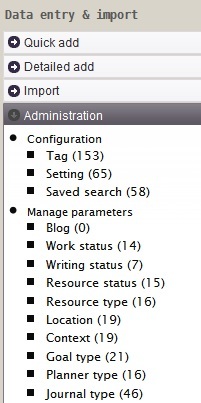
administration-menu.jpg
9.5 Pomegranate Profiles
10 Features and Interface
List of key features…
10.1 Modules menu
module code is often the first character of the default module name. You can change the name from the settings.
G Goals T Tasks …
S Contacts, people, or society
- Saved search. Wide and narrow box presentation.
- Kanban
in planning work or study
w kanban refreshes every 120 seconds. config.
in studying kanban too
- Calendar
- Dashboard
The main pages are the main page, publish, kanban, cal, kpi, the rest is shown in the central region.
b1 kanban, important to know the next step, else we will become lazy after the first achievement and think that we have done it all. In fact, most of the cases laziness follows an ahcievement is when we had not have have clearly the next steps to make. This is especially true for long term and long projects.
getings things entered framework, vs my focus and sequence driven kanban.
Shortcut keyboards. Post 33.
Revising writing through printing and appending new changes. Effective cycle of priting a book draft. making lots of editing and amendments. Updating the writings. Priting again. A book is split into writings and or notes.
Screen components
The main interface is composed of three regions: left, top and central regions.
The left region contains the calendar, the search form, the modules menu and the parameters list.
Command bar: add, update, find ad hoc/HQL, search full text,
Main search form
Quick add
Top right: import and export, calendars, update indicators?, help, batch add
Menu and saved searches e.g. countdown and countups, tables for export
_summary, details for TGRE, add J or P with optional summary text and a date
book covers link to files
Reports
status bar:
check folders…
heartbeat
where is my data?
todo
task creation and completion
todo
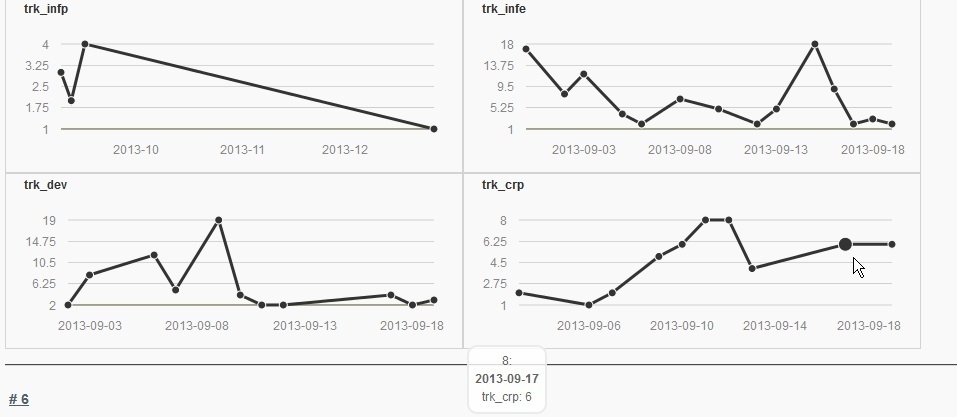
indicators
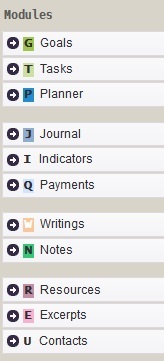
modules-menu

kanban
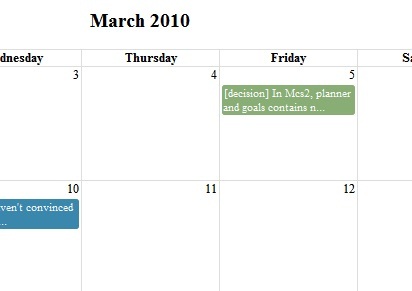
monthly-calendar
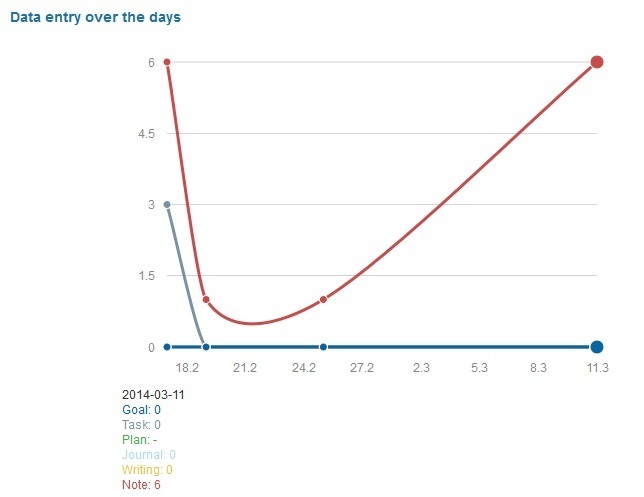
heartbeat
11 Basic Adding and Searching Records
11.1 Basic data entry
3 ways to enter data, from basic to advanced,
quick add form: zero thinking, just paste or type and hit save.
detailed add command bar smart file import, great for importing data from other systems. easy to produce using simple scripts or file rename tools
11.2 Basic search options
Quick search
Quick search field in the top right corner: it does full text seach over all the module records
’'’Form-based search’’’, available on left-hand side of the screen, gives the user the most straightforward way to query the main information types (all except the parameters). It translated the input criteria to HQL query.
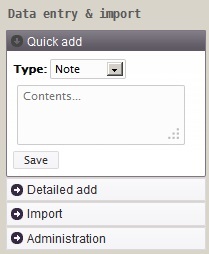
quick-add
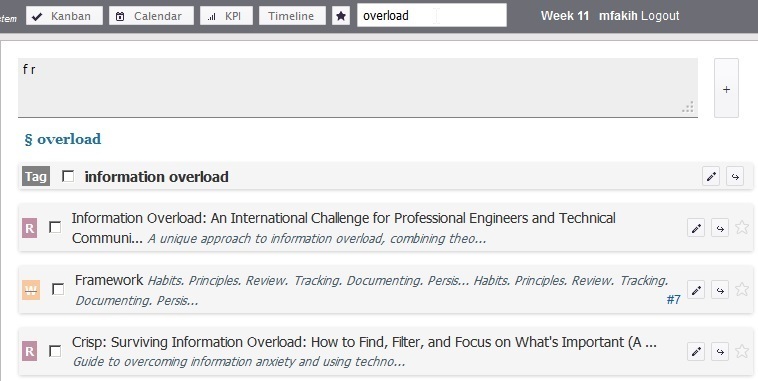
quick-search
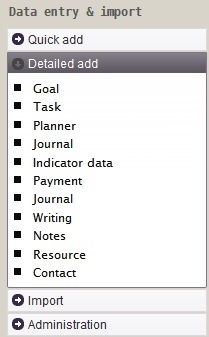
detailed-add

tag-results
12 Advanced Adding and Searching Records
12.1 Advanced data entry
12.2 Smart files to add records
Local installation
Remote installation
12.3 Smart files to update records
Local installation
Remote installation
12.4 Advanced search options
Pomegranate gives the user 4 options to query or search the records:
What is HQL query.
Visit the gallery of saved searches on this link.
Most databases in use today are relational. The standard language to query them is SQL. When tables are mapped to class objects in certain frameworks as in Grails, you can use a language that is more powerful than SQL. You can write shorter code in it, over SQL.
’'’Pomegrante query’’’: available from the command bar, it uses Pomegranate syntax and it is internally translated to HQL query. It is a shorthand notation used for fast queries. The translated HQL query is shown on the screen and can then be stored permanently as saved search. Example ‘f t p3 ?pending #bug’, will find all tasks that are of priority 3, of status ‘pending’ and type ‘bug’. More about this syntax in a later section.
’'’Full text search’’’: backed by Lucene library, it gives full text seach of the text fields of the main information types. It is available from the command line and can be stored as saved search. Lucene syntax is presented on ?. Example ‘s b information overload’ to search all resources (books, articles etc) about the occurrance of the terms information overload
’'’Direct HQL query’’’: available from the command bar and can be stored as saved search. Example ‘q from Task where priority # 3’
’'’Ad hoc query’’’: Similar to direct HQL query but here the user specific what fields he/she wants to be. The results are display in table instead of the long card representation of direct HQL query. Example ‘h select id, summary, status from Task’, to display a table with 3 columns id, summary and status of all tasks. Ad hoc query can be stored as saved search.
12.5 Pomegranate Commands
b1 There are computer languages to do all sorts of things: to write programs, to draw graphics, to analyse data, to play games… Why there is no (or few?) languages to manage our information?! PKM developed simple command for this purpose.
PKM command syntax can change from version to another. There is no need for backward compatibility as commands written in it are short-lived. You can written to be executed immediatly or for short period e.g. when prepared by Pomegranate Offline Data Entry program.
Saved search uses only HQL query, not PKM query. However when you exeucte a PKM query, the equivalent HQL query is shown. You can then use it in a saved search.
export records to text files, for version control, uses flat listing and the field names. So to keep the same structure across PKM updates.
12.6 PKM command format
command type: a (single-line add), A (add with multiline support), f (find, filter), u (update),
[command type] [module code] [field_symbol][parameter_value] ; summary ;; description
s (full text search): Lucene syntax U (import): [blogCode] [post_id]
todo
12.7 Saved searches
Saved searches are one of the main features of Pomegranate PKM system. They are used heavily to build the navigation menu and reports.
A saved search contains a query and a title, with optionally the query to count the total number.
You can use saved query to:
- Get a list of results e.g. all high priority takss
- Get a table where columns maps to recrod fields e.g. get all dates and summary of journal records of type ‘external event’
- Get a random record or records from the list
- Display the results in a table grouped by a certain field e.g. course
- Display the results in a calendar or timeline

pkm2hql-query
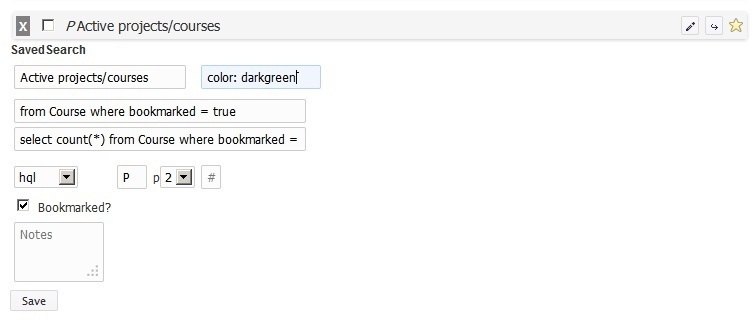
saved-search-record
13 Structure of the Files
13.1 File attached to records
for each module record, the application for a folder and list the records e.g. repository/N/23/ and sandbox/N/23. The metadata of these files ought to be clean from the record’s metadata.
Images attached to records
You can put anything you like in them. e.g. photos of an event.
Audiovisual support
You can see pictures, play audio and video files from it. And you can download or open any file.
HTML5
Comments
You can add comments, called notes, to any module record. The note can have files attached to it. A note has all the common fields of modules (summary, description, priority, tags, status etc), in addition to special fields such as source link.
If there is no information to add with the file, you can just attach the file to the record’s folder directly, without creating a note.
File Organization
document all your computing env. file locations, workflows, input and output. a good exe.
Sandbox and repository file organization model
keep new files aside, review and organize them. import them. they become ready to be copied to their final location in the repository. the repository should not contain at any time files that were not well reviewed and with good metadata. /new can be chaotic but repository should not.
weekly copying imported data to repository. backup before import natural way to make incremental backups. and review what is new. for super safe mind, have the rps acccessed read only for all the time excpet when copying the new and processing sandbox files to it.
PKM read from both the sandbox and repository when you see the details e.g. of a resource. Even when its files are still in the sandbox, you can access them from PKM (sns, location of file - green for files in the sandbox)
model: folder with unchanging names, best with just IDs. what it contains is left for PKM to handle via a record e.g. documentary “asdfasdf” has ID 153. In the file system you will have a folder name 153 under the documenatries folder. This way you will not change the name, have the same folder in another place with a different name, even worse, have it with different contents. very good for backups. help you avoid renaming folder ad hoc. But force you to add metadata in PKM instead.
When you decompose your data into various types as described here you will be more able to come up with adaptive solution, balanced solutions… e.g. data duplication… one grand solution vs different policy for each file type… book are not to be modified. doc… a specific solution to each type… source code -> svn. resources -> checkout… writing updates -> note taken code…
Import and Export
Three ways to import files to Pomegranate
import resources, from the folders of new resource files import smart files from the folder of new smart files online (multiple) file import. need when you don’t have access to the folders on the computer running Pomegranate PKM. attach documents to a record, online.
- ISBN 2 BibTex entry 2 reference
- Publish a course or a writing. Prepare presentation.
out of writing summaries in multipe formats e.g. html, text, wiki beamer, …
where is my data + count of files _folders report to see how many files per folder if all exitst, combined in where is my data
status bar, green if all folders exists
export to R dataset for data analysis and visualization there
export all records to plain text, PKm notation or list format. Put them under a version control e.g. subversion and you ‘ll have a visual way to see exactly what changes, when and how much (in size).
Export to GoodReads. Flag a book for sharing. Get a list of isbn to be imported in GoodReads # Import, export
Importing of video and audio excerpts of resources such as documentaries, movies, audiobook, audio courses, training. Todo
13.2 Bulk Import
Better not to import all your existing files
Plan to import only those that you have read, planning to read or you consider important. And so decluttering your files and putting effort only for the files that deserve the effort of import.
You may choose to start with those that you have already read, watched to listened to, and those you plan to read and those that are important for the future. You keep the rest in a separate folder as a “library” to take file from when need be.
The advantage is that you will know very well your imported file and you will justify the time spent organizing them as they are important. So the first import will be an opportunity to declutter and focus your resources and document files.

import-menu.jpg
14 Pomegranate with Other Applications
14.1 Integration with Text Editors
Text editors are great at editing text. It sounds obvious, but it has an important implication. A good knowledge management system should allow you to use your favorite editor to edit your writing and notes. PKM offers you the possiblity to do so.
The process to edit writing or notes using your editor
- Bookmark the records that you want to work on e.g. all chapters of your current book or the blog posts that you need to update
- (Case of local installation) Click on the “Edit box”, and click “Checkout the records”. A text file will be created for each bookmarked record (sns)
- Edit your files
- When completed (that can be after few days), click on “Edit box” again to see a report of the changes. When all is fine, click “Commit changes” to save the changes
- (Case of remote installation) Download the smart file of each record you want to edit, and save it on your computer
- Edit the file, possibly rename its filename e.g. to update the summary, priority, status fields
- Upload the file from “Upload smart file to update records”
14.2 Integration with WordPress
A writing or note record can be posted with one click to a WordPress blog (or any blog that support XMLRPC protocol). The post will contains its categories and tags.
Future changes to the writing or note record can be posted. They update the same post of in the first posting.
An existing post online can be imported as a note record in Pomegranate with the command i blogCode postId,
especially if you have multiple blogs and you make constant updating to them, with the text editor integration, you can edit your posts as if they are locally-stored text files.
Book citation, when the note is linked to a book, appears at the end the post body. if you use a refenrece [[book id, page]], this notation will be replaced by a refenrece to a footnote or endnote containing the book citation.
14.3 Integration with LeanPub
LeanPub is a self-publishing company that follows the Lean Publishing process. Lean Publishing is “the act of publishing an in-progress ebook using lightweight tools and many iterations to get reader feedback, pivot until you have the right book and build traction once you do.”
In addition to online editing of the book contents, LeanPub supports DropBox integration, where the author put his manuscript in a special format and in a special folder in his DropBox account. The manuscript has to be in Markdown format.
Pomegranate job ends where LeanPub’s starts. Pomegranate helps you in capture and organizing your notes, cited works and chapters, sorting the chapters, compiling the book contents out of all the writings and notes that make up the book, and finally previewing the resulting HTML book before putting it in DropBox folder.
The book writings and notes can be selected dynamically according to certain criteria such as status, type, tag… For example you want to publish all the chapter and sections that do not have status ‘Draft’ or that do not have type ‘Technical’, or that have a tag ‘Intro’ etc.
14.4 Integration with Excel
14.5 With Pomegranate Note taker
produce smart files
line 1 is what goes to the filename
c p4 #snp ; java opts in .sh
body of notes
line 2 of body
results in …
illegal characters
to ensure uniqueness of file name, the first word in the filename will be the datetime. Words that starts with numerals at the start of the filename are ignored.
gte, no spell checker to distract you. no styling, just plain text. although it supported rich text if you entered rich text in it. but it is going to be saved as unicode plain text.
ntk can automatically write the jrm entries whily you are working on other stuff. ntk prompts you every 15 min to write, optionally, a bried description of what you are doing and it takes a shot of the desktop as well.
14.6 With desktop applications
Digikam
First scan short keys, Ctrl + module code to make quick selection. next, or later on, you scan the module that is important or urgent to work on e.g. tasks or notes. Here you do a more detailed processing.
appliance X will have all these integration already in place. It runs Mint 16 x64 bit with KDE on it. The super fast way to have all this ecosystem, including PKE running in few minutes. Just downlaod. Install virtualbox, start the VM. See post 231.
VLC

rss.jpg
15 Advanced features
15.1 Bulk Edit
15.2 Accesing your repository in multiple ways
15.3 Using hard links
III PKM In Action
16 Pomegranate for Project and Task Management
16.1 How PKM it can be used?
It is the integration of the different modules that shows the power and versality of pomegranate…
17 Pomegranate for Personal Development
Journal and planner…
goal and research: goals about research to do or resources to read. conversely, readings starting new goals and tasks.
link goal to journal. when you work on a goal.
goals: power of review old important readings and the highlights on them.
healing power of journaling, confronting the emotions
why planning, journal, documenting the readings, and publishing: sn, majda attacks
keep references, when I talk about an idea that I read, listen or watched aobut, I should be able to reference its source… not just I heard sth and the other one cannot read more about it.
data scattering, duplicate problem
locating very old files
how to read a book - support for excerpt. not necessarily physically done.
sns is not a first class citizen. it should be linked to journal, task, or writing entry. a record can be linked to many photos, not just one.
18 Pomegranate for Writing and Publishing
Append to writing, notes vs. edit them
vs word processor.
the goal is to make very efficient updating to lots of writings at the same time. This reflects how a writer’s mind work. Not serial work over a single topic. That’s very important to do but that’s not the only type of activity. ofter we have many ideas to be put under many writings
Two options to public course writings and notes: individually as posts then order them in the blog, or export the the whole course writings and notes as a single page, then publish that page.
xcd store new ideas in a writing record, then as they stabilize and grow in size, split them to notes attached to the writing record.
19 Pomegranate for Researches and Students
Journal and academic
Citations
Actionns on resource records:
Fetch Bib entry
Generate citations
PKM fetches Bibtex entry for the book from the internet (?), and then generate the citation in the format defined in the settings and in three format: plain text, Html and AsciiCode. But you can edit them if need be.
Batch action: Fetch Bib entry
Generate citations for all those that have ISBN but not bib entry, or no citations…
config, citation style format.
Saved search to see the records that will be processed…
Footnote expand
Getting resource metadata
One way is by parsing the bib tex entry… so it is one way to get (basic set) of metadata…
journal Indicators
time tracking: planned task duration, actual duration, goal progress
quantitative/precise time tracking for tasks qualitative progress tracking for goals
general for dept, ind type, activity type time budget
track # ticks. define indicators that start with the letter trk e.g. trk_web
Indicators dual function. to make sure data changes reflect that you do vs accidental folder move etc.
indicator can calculate query and number of files with a certain extension in a folder on the server of your choice…
monkey work, typing paper handwritten, transcribing voice notes, K sessions. The important part is to have the paper notes and voice notes sequenced and clear to allow typing them without thinking
Uses Quotes linked to topics or writings. Review them together and see their similarities, contradictions, differences. You can try to combine them in one synthesis.
19.1 Voice note integration
vcn autoimport by location vs filename rename.
First scan of them to transcribe immediatly some of them, trash the unneeded ones, split by module as in photos. Intentionally, a minimal level of work is needed before an import to ensure a review of files, sensing that they represent a load, not just throw out files in a system and hoping that it will magically get things organized for you. Garbage in, garbage out. To decrease the possibility at mass import of unneeded files.
writing status, transcribed, markcomplete will does this
voice notes integration, is an example of knowledge in action. one minute talk, followed by hours to integration the feature, and months to form the habit.
19.2 Lean publishing
to blogs, “good blogs are beta books”. expot easily the books. from here, platforms for lean publising takes your books to the distributions level.
saved search wnj updated after publishing but the change need not be in a field that does not affect the post information e.g. the status of a post is not posted to the blog.
19.3 Track milestone and notable events
little “gadgets”, you can define the date you first started using Pomegranate in the settings. You will see a counter of days and years in the status region. You can define any date you like, for instance, your age. This way you can keep track of how old you are in days.
to transform to ss and jp entries, ad hoc h and homepage
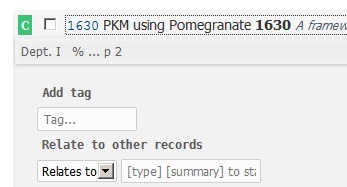
add-relationship
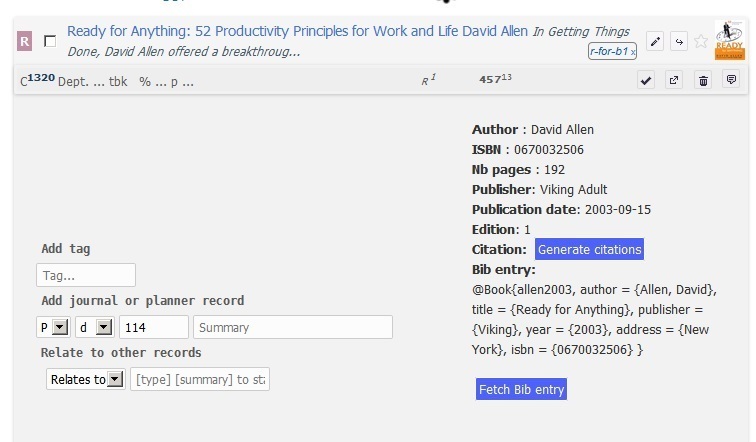
.book-details.jpg

books-sample

calendar.jpg

comparing-writings-smartsvn.jpg
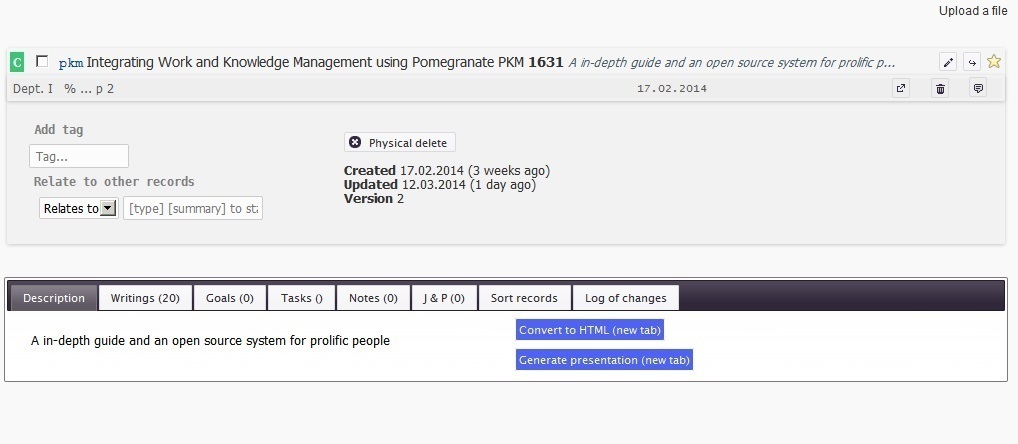
course-page.jpg
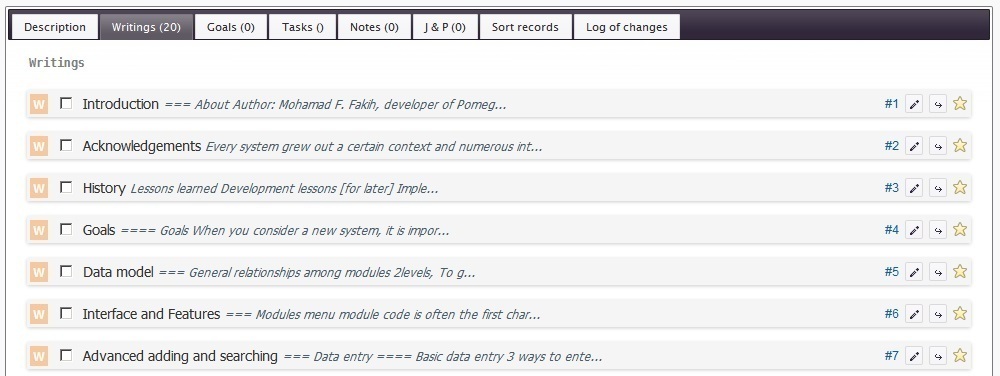
course-writings.jpg
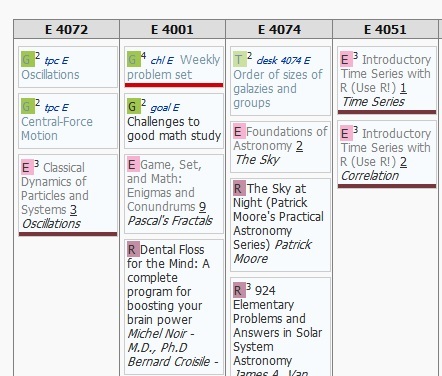
courses-kanban.jpg
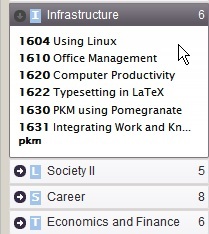
departments-courses.jpg
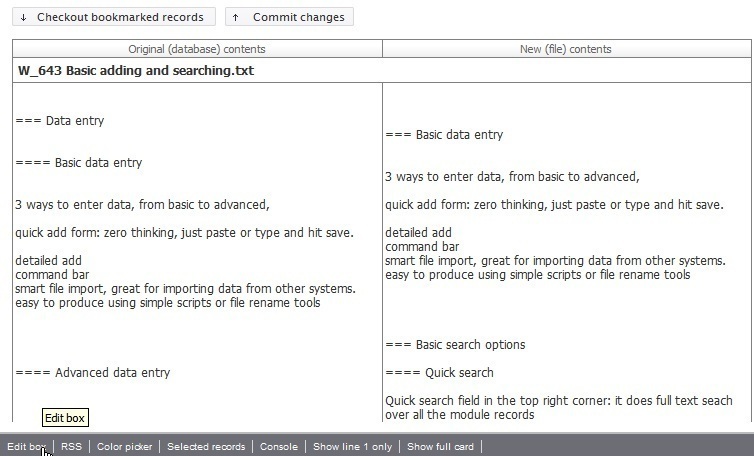
editbox-sample.jpg

excerpts.jpg
20 Pomegranate and Paper Work
Paper templates to support the use of Pomegranate and help build new habits, as paper can accompany longer and in all situations.
Planner and journal template
image…
Time tracking template
image…
JP Binder
image… # The ecosystem
Pomegranate PKM does not work in isolation. It integrates with a variety of other software, mostly open source too, to get the job done. It is part of a software and hardware ecosystem. Such ecosystem is the subject of my blog at SoftwareGems.org.
Pomegranate grew out of experimenting and applying new ideas suggested by books and courses. Such ideas and books are the subject of my blog at 2fkar.org.
21 Collaboration
3 ways to user Pomegranate PKM
personal, single account
flat open collarobation, wiki style
admin sees all and control what each one can see. less feature, no arbitrary query feature available. responsability shits to the admin to design the right saved searches for them. they can add, and see the records allowed in the saved search -# Pomegranate Under the hood
Developed in Grails framework 2.2.3 (although the first version was in 1.1.1), which is based on Groovy language, a dynamic language on top of the Java platform. Grails applications runs can run it on any platform that supports Java, so practically all platforms including Windows, Linux, Mac. Tomcat is the recommended and open source application server to run it.
Code metrics Developed in Grails
Todo
image
? domain classes, ? (mammoth) controllers, ? gsp pages (main page, kanban, calendar, record, publish, presentation) and ? gsp templates. Most of what you see is stored in gsp templates.
lines of codes, # pages if printed on A4…
Pomegrante installation zip file is a bundle of Tomcat, optionally with a Java runtime environment, if you do not have one, cannot install it or want to get PKM up and running in the shortest amount of time with no configration.
21.1 Security
- The application is protected using Grails Spring Security plugin. The users and roles are stored in the database of the application.
21.2 Privacy
PKM and internet connections
In and out
to blog from blog from www.ottobib.com/ from Amazan (license no longer allows storing metada in the database) - looking for alternatives
22 License of Pomegranate PKM
Pomegranate PKM is free software: you can redistribute it and/or modify it under the terms of the GNU General Public License as published by the Free Software Foundation, either version 3 of the License, or (at your option) any later version.
22.1 Legal disclaimer
Pomegranate PKM is distributed in the hope that it will be useful, but WITHOUT ANY WARRANTY; without even the implied warranty of MERCHANTABILITY or FITNESS FOR A PARTICULAR PURPOSE. See the GNU General Public License for more details.
22.2 License of the book, blog and presentation
This book, PKM documentation and PKM blog posts are licensed under a Creative Commons Attribution-NonCommercial-ShareAlike 3.0 Unported License # Postscript
22.3 How this presentation was made?
This book was written and managed in Pomegranate PKM itself.
image of W records
22.4 Keep informed
Subscribe to the newsletter on the PKM website
Like it on Facebook, follow it on Twitter.
Plan, journal, research, and writing using Pomegranate. It is what you do with it that is the most important.
